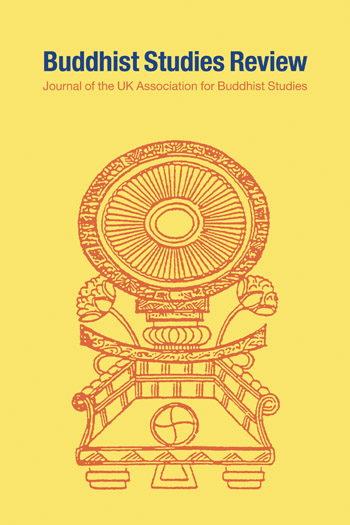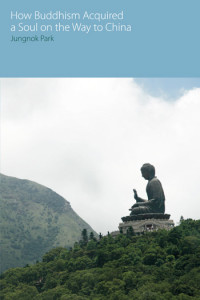Sermon of One Hundred Days
Part One
Contributing Author
Venerable Seongcheol [+–]
View Website
Seongcheol (April 6, 1912 – November 4, 1993) is the dharma name of a Korean Seon (Zen) Master.[1] He was a key figure in modern Korean Buddhism, being responsible for significant changes to it from the 1950s to 1990s.– from Wikipedia entry
Edited by
Linda Covill [+–]
Writer and Translator
Linda Covill is a Sanskritist, writer and translator in the field of Buddhist Studies. She is the author of Handsome Nanda (New York University Press / JJC Foundation, 2007) and A Metaphorical Study of Aśvaghoṣa’s Saundarananda (Motilal Banarsidass, 2009).
Translated by
Hwang Soon-II [+–]
Dongguk University
Hwang Soon-II is Assistant Professor of Indian Philosophy at the College of Buddhist Studies, and Associate Dean of International Programmes and Education at Dongguk University, Seoul. His is the author of Metaphor and Literalism in Buddhism: The Doctrinal History of Nirvana (2006).
Translated by Hwang Soon-Il, Assistant Professor of Indian Philosophy at the College of Buddhist Studies, and Associate Dean of International Programmes and Education, at Dongguk University, Seoul
Sermon of One Hundred Days is the first translation into English from Korean of a seminal text in Korean Buddhism. Buddhism was introduced into Korea through China in about the 4th-5th century C.E. and within 200 years became so advanced that it influenced the development of Chinese Buddhism. Chan Buddhism was introduced into Korea around the 8th century and Seon Master Jinul (1158-1210) is honoured as having set the curriculum for the education of Buddhist monks and established Korean Buddhism as it was known for the next millennium.
In this Sermon of One Hundred Days, published in 1967, Master Seongcheol (1912-93) develops Korean Buddhism further by teaching what Buddhist truth is. This Sermon comprehends the vast developments of Buddhism in India and China, including early Buddhism, Abhidharma, Madhyamaka, Yogācāra Buddhism, Chinese doctrinal schools of Tiantai and Huayan and Chinese Chan and Korean Seon Buddhism. The Master analyses the logical structure of various historical teachings, which are connected by the principle of ‘the middle way,’ and encourages his audience to pursue solely the truth to which the Buddha awakened.
Table of Contents
Prelims
The Romanization of the Korean Language (Hangeul) [+–] vii – viii
Seongcheol (April 6, 1912 – November 4, 1993) is the dharma name of a Korean Seon (Zen) Master.[1] He was a key figure in modern Korean Buddhism, being responsible for significant changes to it from the 1950s to 1990s.– from Wikipedia entry
Translated by Hwang Soon-Il, Assistant Professor of Indian Philosophy at the College of Buddhist Studies, and Associate Dean of International Programmes and Education, at Dongguk University, Seoul Sermon of One Hundred Days is the first translation into English from Korean of a seminal text in Korean Buddhism. Buddhism was introduced into Korea through China in about the 4th-5th century C.E. and within 200 years became so advanced that it influenced the development of Chinese Buddhism. Chan Buddhism was introduced into Korea around the 8th century and Seon Master Jinul (1158-1210) is honoured as having set the curriculum for the education of Buddhist monks and established Korean Buddhism as it was known for the next millennium. In this Sermon of One Hundred Days , published in 1967, Master Seongcheol (1912-93) develops Korean Buddhism further by teaching what Buddhist truth is. This Sermon comprehends the vast developments of Buddhism in India and China, including early Buddhism, Abhidharma, Madhyamaka, Yogācāra Buddhism, Chinese doctrinal schools of Tiantai and Huayan and Chinese Chan and Korean Seon Buddhism. The Master analyses the logical structure of various historical teachings, which are connected by the principle of ‘the middle way,’ and encourages his audience to pursue solely the truth to which the Buddha awakened.
Foreword by Hwang Soon-Il [+–] ix – xi
Dongguk University
Hwang Soon-II is Assistant Professor of Indian Philosophy at the College of Buddhist Studies, and Associate Dean of International Programmes and Education at Dongguk University, Seoul. His is the author of Metaphor and Literalism in Buddhism: The Doctrinal History of Nirvana (2006).
Translated by Hwang Soon-Il, Assistant Professor of Indian Philosophy at the College of Buddhist Studies, and Associate Dean of International Programmes and Education, at Dongguk University, Seoul Sermon of One Hundred Days is the first translation into English from Korean of a seminal text in Korean Buddhism. Buddhism was introduced into Korea through China in about the 4th-5th century C.E. and within 200 years became so advanced that it influenced the development of Chinese Buddhism. Chan Buddhism was introduced into Korea around the 8th century and Seon Master Jinul (1158-1210) is honoured as having set the curriculum for the education of Buddhist monks and established Korean Buddhism as it was known for the next millennium. In this Sermon of One Hundred Days , published in 1967, Master Seongcheol (1912-93) develops Korean Buddhism further by teaching what Buddhist truth is. This Sermon comprehends the vast developments of Buddhism in India and China, including early Buddhism, Abhidharma, Madhyamaka, Yogācāra Buddhism, Chinese doctrinal schools of Tiantai and Huayan and Chinese Chan and Korean Seon Buddhism. The Master analyses the logical structure of various historical teachings, which are connected by the principle of ‘the middle way,’ and encourages his audience to pursue solely the truth to which the Buddha awakened.
Chapter 1
Introduction [+–] 1 – 38
Seongcheol (April 6, 1912 – November 4, 1993) is the dharma name of a Korean Seon (Zen) Master.[1] He was a key figure in modern Korean Buddhism, being responsible for significant changes to it from the 1950s to 1990s.– from Wikipedia entry
There are many ways to explain what Buddhism is. I will do so by making use of a variety of doctrines and sayings, and what follows may challenge what you believe Seon Buddhism to be. What then is Buddhism? It looks simple, but looks can be very deceptive. This question cannot be answered in a word. Some religions are based on one or two principal texts such as the Bible or the Koran. Buddhism, by contrast, relies on the vast number of texts contained in the Buddhist Canon (known as the Tripi¢aka Koreana). One text may say one thing and others may differ greatly. Even those with knowledge and understanding of these texts find it difficult to formulate a succinct definition of Buddhism.
Chapter 2
Early Buddhist Thought [+–] 39 – 77
Seongcheol (April 6, 1912 – November 4, 1993) is the dharma name of a Korean Seon (Zen) Master.[1] He was a key figure in modern Korean Buddhism, being responsible for significant changes to it from the 1950s to 1990s.– from Wikipedia entry
The Buddhist middle path already in its first formulation consisted of non-attachment to either of two contrasting extremes, such as existence and non-existence or arising and ceasing. The concept can be traced back to the first sermon of the Buddha after his awakening, known as the Discourse Setting in Motion the Wheel of the Law (Dharma-cakra-pravartana Sμutra). There are many essential teachings in this discourse and the theory of the middle path is one of them. The teaching here is simple and concise. It applies in a practical way to one who has gone forth from home to homelessness. It is important to bear the origins of this theory in mind.
Chapter 3
The Madhyamaka [+–] 78 – 94
Seongcheol (April 6, 1912 – November 4, 1993) is the dharma name of a Korean Seon (Zen) Master.[1] He was a key figure in modern Korean Buddhism, being responsible for significant changes to it from the 1950s to 1990s.– from Wikipedia entry
The Madhyamaka School, established by Nāgārjuna in around 150 to 250 CE, is one of the Indian Mahāyāna schools. Nāgārjuna was born into a Brahmin family in South India and brought up with a traditional Hindu education. Although he was clever, he was initially addicted to physical pleasures. When he realized that such desires are not conducive to happiness but to misery and suffering, he went forth1 at a stūpa on a mountain. He first learned Mahānayāna Buddhism, but he remained unsatisfied. He was looking for deep and profound teachings. He eventually acquired Mahāyāna texts and was awakened to the truth of Mahāyāna Buddhism. He dedicated the rest of his life to propagating the ideas of Mahāyāna Buddhism.
Chapter 4
The Vijñapti-mātra [+–] 95 – 158
Seongcheol (April 6, 1912 – November 4, 1993) is the dharma name of a Korean Seon (Zen) Master.[1] He was a key figure in modern Korean Buddhism, being responsible for significant changes to it from the 1950s to 1990s.– from Wikipedia entry
The Vijñapti-mātra is one of the most famous of India’s Mahāyāna Buddhist schools. While the Madhyamaka school is mainly associated with the theory of emptiness, the Vijñapti mātra tradition asserts that everything is consciousness (vijñāna) only. It can be traced back to the Buddha, but was systematized by Maitreya, Asanga and Vasubandhu.
Chapter 5
The Mahā-parinirvāna Sūtra [+–] 159 – 166
Seongcheol (April 6, 1912 – November 4, 1993) is the dharma name of a Korean Seon (Zen) Master.[1] He was a key figure in modern Korean Buddhism, being responsible for significant changes to it from the 1950s to 1990s.– from Wikipedia entry
The Mahā-parinirvāna Sūtra makes some of the most detailed and frequent references to the middle path of all the many Mahāyāna sμutras. The principal theory presented in the Mahā-parinirvāna Sūtra is that every living being has the Buddha nature. But what is the meaning of the Buddha nature? The Buddha nature in every living being is the middle path, since it tends neither to existence nor non-existence, neither to permanence nor annihilation. The content of the middle path is the truth of the twelve links of dependent origination as rightly understood by the Buddha on the eve of his awakening. It is the middle path since it abandons views of both annihilation and permanence. I will quote three passages from the Mahā-parinirvāna Sūtra which relate to the Buddha nature and the middle path.
Epilogue
Epilogue [+–] 167 – 169
Seongcheol (April 6, 1912 – November 4, 1993) is the dharma name of a Korean Seon (Zen) Master.[1] He was a key figure in modern Korean Buddhism, being responsible for significant changes to it from the 1950s to 1990s.– from Wikipedia entry
Epilogue
Glossary
Glossary [+–] 170 – 174
Dongguk University
Hwang Soon-II is Assistant Professor of Indian Philosophy at the College of Buddhist Studies, and Associate Dean of International Programmes and Education at Dongguk University, Seoul. His is the author of Metaphor and Literalism in Buddhism: The Doctrinal History of Nirvana (2006).
glossary
Index
Index [+–] 175 – 179
Dongguk University
Hwang Soon-II is Assistant Professor of Indian Philosophy at the College of Buddhist Studies, and Associate Dean of International Programmes and Education at Dongguk University, Seoul. His is the author of Metaphor and Literalism in Buddhism: The Doctrinal History of Nirvana (2006).
index








